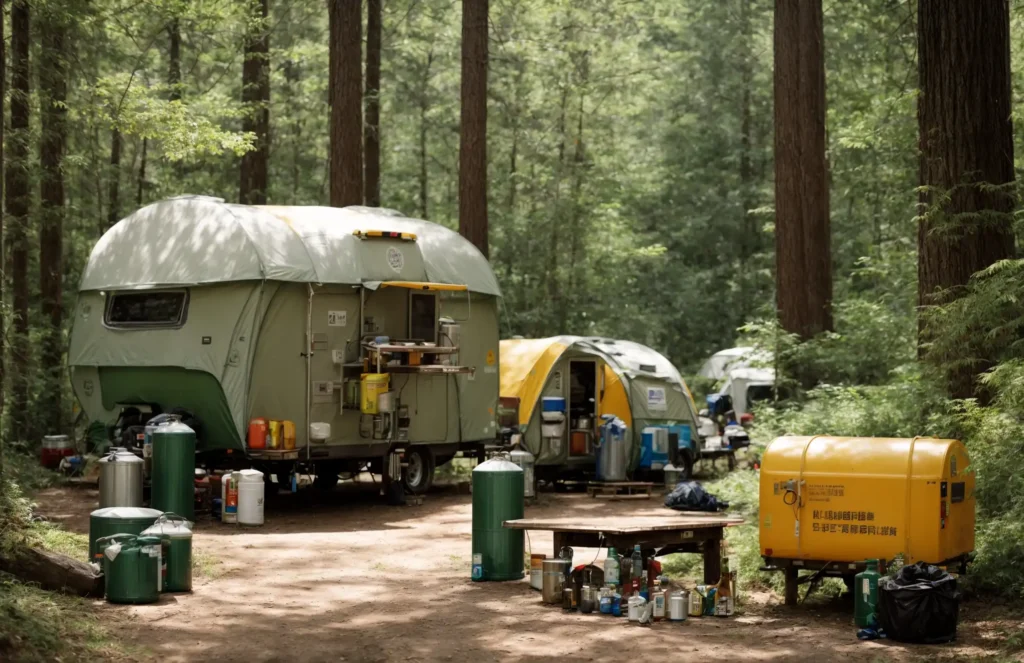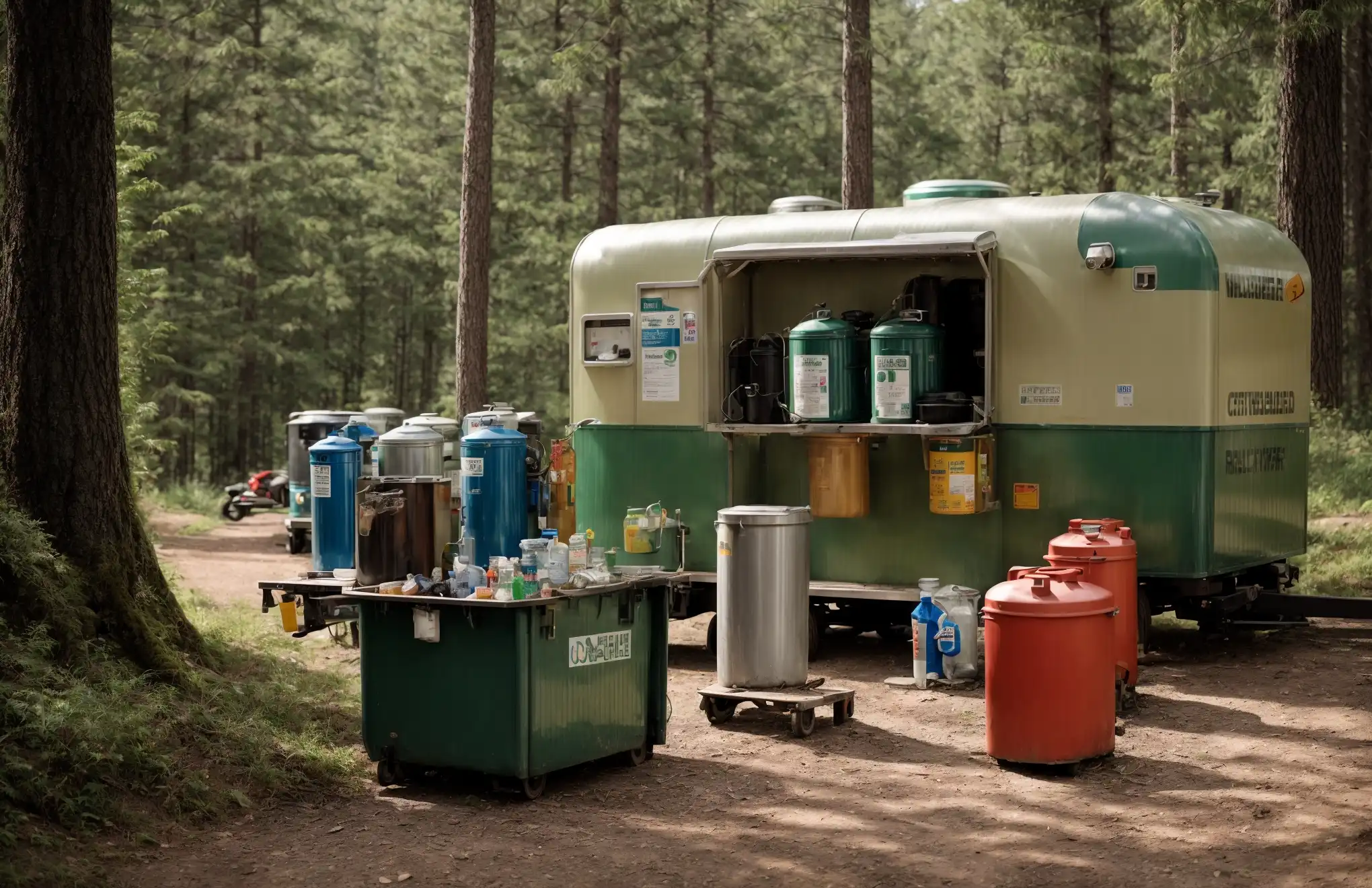To dispose of camping gas canisters, first ensure they’re completely empty. Then, puncture non-refillable canisters following local regulations for disposal.
Camping adventures often include the convenience of portable gas canisters for cooking and heating. Yet, when these canisters run dry, it’s critical to handle them responsibly to minimize environmental harm. Disposing of them correctly avoids potential hazards and adheres to sustainable outdoor practices.
Embracing eco-friendly habits, outdoor enthusiasts must prioritize the safe disposal of these containers. Ensuring a canister is entirely depleted before proceeding protects wildlife and conserves natural resources. Remember, every action counts when it comes to preserving the great outdoors for future generations. By taking simple steps to properly discard used gas canisters, campers demonstrate respect for nature and align with conservation efforts.
About Camping Gas Canister Disposal
Embarking on a camping trip promises adventure and serenity, but it also comes with the responsibility of maintaining the pristine nature we cherish. An often-overlooked aspect of outdoor ethics is the correct disposal of camping gas canisters. These canisters provide a convenient source of fuel for camp stoves and lanterns, but their disposal can impact the environment significantly if not handled properly. Learning the proper ways to dispose of camping gas canisters is crucial.
Understanding the Importance of Proper Disposal
The importance of proper disposal of camping gas canisters cannot be overstated. Protecting wildlife, preserving natural beauty, and helping to prevent potentially harmful pollutants from contaminating soil and waterways are all compelling reasons to dispose of these canisters responsibly. Safety is also a key consideration, as improper disposal can lead to dangerous situations, like explosions or the release of harmful chemicals.

Different Types of Camping Gas Canisters
Camping gas canisters come in a variety of types, each requiring a specific disposal method. Understanding these differences is essential in ensuring effective and environmentally friendly disposal. Here’s a brief overview:
- Single-Use Canisters: Typically butane or a butane-propane mix, these are not refillable and need specific attention to ensure they’re completely empty before disposal.
- Refillable Canisters: Often larger, these can be refilled at designated locations and require periodic maintenance.
- Pierceable Cartridges: These are pierced upon use and cannot be resealed, posing unique challenges for disposal.
It’s essential to identify your canister type and follow the appropriate disposal procedure to minimize environmental impact.
Pre-disposal Preparations
Welcome to the crucial phase of your outdoor adventure – Pre-Disposal Preparations for camping gas canisters. Proper disposal is a vital step for both environmental protection and personal safety. This guide ensures you are well-equipped to handle your gas canisters responsibly once the flame of your camp stove has been extinguished for the last time.
Ensuring the Canister is Completely Empty
Never dispose of a partially filled canister. Residual gas can pose serious hazards. To confirm the canister is empty, follow these steps:
- Operate your gas appliance until the flame goes out to burn off any remaining gas.
- If there is no device to consume the gas, release the remaining content by following the manufacturer’s safety instructions.
- Listen for the hiss of escaping gas and allow it to continue until it ceases completely, indicating an empty canister.
After ensuring the canister is empty, you are ready for the following step in the disposal process.
Removing any Attachments or Valves
Once emptied, prepare the canister for recycling or disposal by dismantling removable parts. Start by:
- Detaching hoses or connectors linked to your camping stove or lantern.
- Inspecting the canister for any detachable valves or rings that may need removal.
- Using appropriate tools to remove these parts only if it’s safe and recommended by the manufacturer.
If you’re unsure about how to safely detach these parts, consult the canister’s user manual or seek guidance from a professional.
Disposal Options For Empty Canisters
Ensuring that camping gas canisters are disposed of responsibly is crucial for environmental conservation and safety. While enjoying the great outdoors, it’s important to understand the disposal process for these canisters once they’re emptied. Here are the most reliable methods to ensure canisters are disposed of properly.
Recycling Facilities that Accept Gas Canisters
One of the most sustainable options for disposing of your empty gas canisters is to recycle them. Not all recycling centers are equipped to handle these items, as they require specialized handling due to residual gas that could be left inside. Here’s how you can locate the right facility:
- Check with your local recycling program to confirm whether they accept camping gas canisters.
- Visit websites such as Earth911 to find recyclers that specialize in this type of waste.
- Reach out to outdoor retailers, as some offer take-back programs for canisters purchased from their stores.
Specialized Disposal Programs For Hazardous Waste
Gas canisters are often treated as hazardous waste, and therefore may require specialized disposal. Many areas run occasional hazardous waste collection events or have dedicated facilities for such items. To make use of these programs:
- Search for “hazardous waste disposal near me” online, and you’ll find designated drop-off locations.
- Always call ahead to confirm that the facility accepts gas canisters and learn about any necessary preparation steps.
Local Campsite Regulations and Policies
Last but certainly not least, adhere to the guidelines established by the campsites you visit. Each location may have its unique policies regarding the disposal of gas canisters. It is crucial to:
Understand and comply with the campsite’s specific regulations.
Look for onsite disposal instructions or facilities, which sometimes include designated canister disposal units.
Ask campsite personnel if they offer their disposal services for used canisters.
The Do’s and Don’ts Of Canister Disposal
Whether you’re a seasoned camper or a weekend warrior, dealing with camping gas canisters responsibly is a crucial part of outdoor etiquette. Understanding the do’s and don’ts of canister disposal ensures not only your safety but also the well-being of the environment. This guide will springboard your knowledge into action, providing you with straightforward advice on how to manage your gas canisters once they’ve fueled your adventures.
Safety Measures to Follow During Disposal
Safety is paramount when disposing of camping gas canisters. These pressurized containers can be hazardous if not handled correctly. Follow these steps to ensure proper disposal:
- Ensure the canister is completely empty before considering disposal. Let the gas run out naturally by attaching it to your appliance until it stops working.
- Do not puncture or incinerate the canister if you’re unsure whether it’s empty. Instead, seek professional advice.
- Wear gloves and protective eyewear if you decide to puncture the canister using a canister recycling tool, available at outdoor stores.
- Once punctured, recycle the canister as scrap metal at appropriate recycling centers that accept mixed metals.
- Keep the empty canisters out of reach of children and away from direct sunlight until they are recycled.
Common Mistakes to Avoid
Even the most experienced campers can slip up from time to time. Here are some common errors you should sidestep:
- Avoid disposing of canisters in general waste bins or landfills. These pressurized containers can cause explosions when compacted in garbage trucks or landfills.
- Do not attempt to refill single-use canisters. This is hazardous and typically illegal, as improper refilling can lead to leaks and explosions.
- Resist the temptation to simply abandon canisters in the outdoors. Even if you believe them to be empty, they can pose a risk to wildlife and the environment.
- Never dispose of canisters in campfires or bonfires. Heat can cause them to explode, potentially leading to injury or wildfires.
- Skipping the step of checking local disposal regulations could lead to environmental harm or fines. Different areas may have specific rules regarding the disposal of camping gas canisters.
Being mindful of these guidelines will not only ensure your safety but also help to preserve the natural beauty of your camping spots for years to come. Make sure you’re always thorough with your gas canister disposal—Mother Nature thanks you in advance!
Eco-friendly Alternatives and Innovations
With the rise in eco-consciousness, outdoor enthusiasts are exploring new ways to minimize their environmental footprint. In the realm of camping, one cannot overlook the impact of gas canisters. Traditionally disposed of without much thought, today’s campers are seeking options that better align with their values of preserving nature. Let’s delve into the realm of eco-friendly alternatives and innovations that are not just good for the environment but also ingenious in their design and application.
Reusable Gas Canister Systems
The shift towards reusable gas canister systems is a significant leap in reducing waste. These canisters, designed for multiple refills, offer a practical alternative to the use-and-toss approach. Not only do they curb the amount of waste generated, but they also prove to be more cost-effective in the long run. Leading outdoor companies have adopted this model, offering refill stations across various locations, thus making it convenient for campers to recharge their canisters whenever they run low.
Some of the key benefits include:
- Decreased environmental impact by reducing landfill waste
- Enhanced sustainability of camping gear
- Lower overall expenses for consumers with initial investment
Advancements in Biodegradable Materials
Research and development in the area of biodegradable materials are uncovering thrilling possibilities for camping gas canisters. Innovative companies are experimenting with materials that can break down naturally, without leaving harmful residues. This pioneering approach positions biodegradable canisters as a groundbreaking solution for responsibly managing camping waste. Campers can look forward to a future where they can dispose of gas canisters with peace of mind, assured that their waste will not harm the environment.
Highlighted features of these materials include their ability to:
- Disintegrate into non-toxic components
- Integrate seamlessly back into the ecosystem
- Offer an alternative to conventional plastic or metal canisters
Supporting Sustainability in Camping Practices
Developing sustainable habits amongst the camping community is vital. Beyond products, it’s about cultivating practices that support sustainability. Campgrounds initiate recycling programs specifically for gas canisters, blending convenience with conscious camping. Workshops and online platforms educate campers on the importance of proper disposal and recycling. These collective efforts help maintain the pristine nature of our wild spaces while setting a positive example for future generations of nature enthusiasts.
Camping practices that promote sustainability include:
| Practice | Benefit |
|---|---|
| Using refillable canisters | Reduces single-use waste |
| Participating in take-back programs | Ensures proper recycling |
| Choosing products with minimal packaging | Decrease in overall waste generated |
Learn more: How to Dispose of Empty Camping Propane Tanks
Conclusion
Disposing of camping gas canisters responsibly is vital for environmental protection. Remember to empty, puncture, and recycle them properly. Adhering to these steps ensures you leave no trace. Thank you for prioritizing sustainability while enjoying the great outdoors.
Your next outdoor adventure is just an article away. Visit the Learning section at Outdoor Awaits for insightful camping tips. Safe travels and happy camping!
Sukhen is a passionate blogger and traveler who visited many historical places in Bangladesh, Myanmar, India, and Thailand. He's an avid camper, so he shares his knowledge of camping and wildlife with his readers. He also helps readers plan their own camping trips. To know more, stay connected with Outdoor Awaits.

